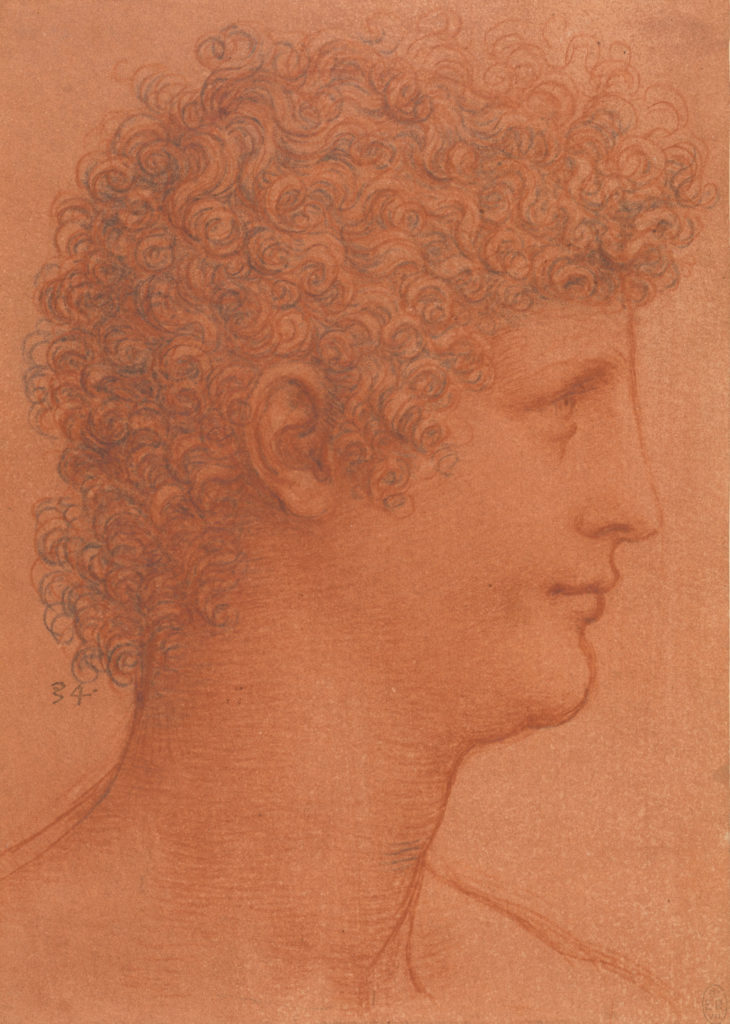via ResearchBuzz Firehose: Kate Brown in artnet news

Leonardo da Vinci's The head of a youth (c.1510). Courtesy the Royal Collection Trust.
To mark the 500th anniversary of the Leonardo da Vinci‘s death, a collection of his drawings are going on a UK tour next year. But if you think that “Leonardo da Vinci: A Life in Drawing,” as the show is called, is just a Renaissance man greatest hits tour, think again. There will be surprises.
Some 144 extraordinary illustrated works will be displayed in 12 simultaneous exhibitions at various cities across Britain. These exhibitions will open in tandem in February 2019, before being brought together to be exhibited that May at the the Queen’s Gallery at Buckingham Palace. All in all, there will be a total of 200 sheets on display there, making it the largest exhibition of the artist’s work in over 65 years.
The revelations in the show come thanks to modern technology. Infrared light is used to show hidden drawings and alternative versions of Leonardo’s sketches.
Continue reading
==============================
via Interesting Literature
On a little-known poem by a forgotten modernist
Lola Ridge (1873-1941) is not much-remembered now, much less read. Yet she was one of a number of female modernist poets active in the first half of the twentieth century: poets who helped to move English (or Anglophone: Ridge herself was not English) verse away from roses and iambic pentameters and into fresh new territory. Her short poem, ‘Mother’, gives a snapshot of her distinctive style.
Continue reading
==============================
via the OUP blog by Sebastian Sobecki

When an army of Kentish insurgents gathered south of London on 12 June 1381, the firebrand priest John Ball is said to have addressed them with a subversive proverb: “When Adam delved and Eve span, where was then the gentleman?” On the following day, the rebels flooded into London, orchestrating spectacles of political violence. They razed the sumptuous Savoy Palace of John of Gaunt, King Richard II’s despised uncle, and beheaded both the treasurer of England and the archbishop of Canterbury.
The Great Rising of 1381 was a politically literate revolt. The rebels clamoured for social justice; they demanded dignified labour conditions and, above all, access to land and game. Their access to reading and writing reveals that they also received support from what Kathryn Kerby-Fulton calls the “clerical proletariat”. This was England’s first revolution, anticipating in its scope and ambition many of the lofty goals laid out three hundred years later in Jean-Jacques Rousseau’s milestone treatise On the Social Contract (1762).
Continue reading
==============================
via 3 Quarks Daily: Roger White at n+1

There are some painters whose influence on the course of painting is so diffuse as to become unremarkable. This is the case with the illustrious octogenarian David Hockney. Without him, it’s hard to imagine the category of queer figurative painting, for example, or the casual semi-abstraction seen lately in much American art. The point goes double for painting in Los Angeles, the city where Hockney has made most of his work, with its cerulean swimming pools, indolent bathers, and cubist highways, and which now looks (the city, and much of its painting) like the displaced Yorkshireman’s art.
Continue reading
==============================
via Arts & Letters Daily: Joseph Epstein in CRB

“The object of all good literature,” thinks Sue Brown, a chorus girl and a character in P.G. Wodehouse’s novel Summer Lightning, “is to purge the soul of its petty troubles.” Something to it, quite a bit actually, though Céline, Samuel Beckett, Edward Albee, and a number of other modern writers who pass for serious would strenuously have disagreed. The writing of P.G. Wodehouse—the author of some 95 books of fiction and three of memoir, recently republished in a handsome hardbound collection by Everyman’s Library in London and The Overlook Press in New York—was not merely unserious but positively anti-serious, and therein lay much of his considerable charm.
Continue reading
And maybe remind yourself, as I did, that it’s ages since I read any PG Wodehouse although I have several of his books on my bookshelf.
==============================
via Boing Boing by Andrea James

Illustris TNG is a theoretical astrophysics project that created the most detailed simulation of the universe to date, and it turns out that black holes influence the distribution of dark matter.
Continue reading
==============================
via the Guardian by Maev Kennedy

As well as the cross, gold and garnet pins, an iron knife, glass beads and a chain were also found in the grave. Photograph: Stuart J Roberts/ University of Cambridge
A beautiful gold and garnet cross, found on the breast of a teenage girl buried lying on her own bed about 1,300 years ago, has been presented to the Museum of Archaeology and Anthropology in Cambridge.
The girl’s grave was found in 2011 by University of Cambridge archaeologists only a few miles from the museum, on land at Trumpington being developed for housing. The bed on which she lay – probably her own – had rotted into the soil centuries ago leaving only the iron supports, but the cross stitched onto the dress which became her shroud was still gleaming.
Continue reading
==============================
via Big Think by Massimo Pigliucci
People get angry for all sorts of reasons, from the trivial ones (someone cut me off on the highway) to the really serious ones (people keep dying in Syria and nobody is doing anything about it). But, mostly, anger arises for trivial reasons. That’s why the American Psychological Association has a section of its website devoted to anger management. Interestingly, it reads very much like one of the oldest treatises on the subject, On Anger, written by the Stoic philosopher Lucius Annaeus Seneca back in the first century CE.
Seneca thought that anger is a temporary madness, and that even when justified, we should never act on the basis of it because, though ‘other vices affect our judgment, anger affects our sanity: others come in mild attacks and grow unnoticed, but men’s minds plunge abruptly into anger. … Its intensity is in no way regulated by its origin: for it rises to the greatest heights from the most trivial beginnings.’
Continue reading
==============================
via Boing Boing by Andrea James

YouTuber NightHawkInLight got his hands on some thick copper plates and some neodymium magnets, then showed some of the strange ways the two materials interact.
Continue reading (and watching)
==============================
via Interesting Literature
Are these the greatest heart poems?
Poets have often written about the heart. Whether they’re discussing desire, or being broken-hearted by loss or unrequited love, or the boundless joy they feel in their hearts when encountering the wonders of the natural world. Here are ten of the best poems featuring hearts.
Continue reading
Not sure about best but the ten quoted contain eight of my favourites.
No comments:
Post a Comment